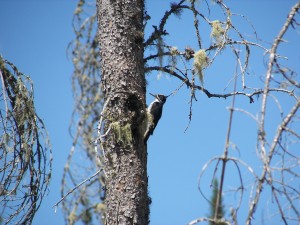
May is a fascinating month to be birding in the Adirondacks! The excavators are busy hollowing out tree space to raise young. In the past week, I have found two Black-backed Woodpecker nest sites, a Red-breasted Nuthatch nest, a Black-capped Chickadee nest, two likely Boreal Chickadee nest locations, and countless Yellow-bellied Sapsucker nests! The Jeopardy category would be titled “species that excavate nest holes”. Early to mid May is the best time to hear the sounds of the excavating activity.
Black-backed Woodpecker males do all the work of excavating a nest cavity. A male will change locations with the female long enough for her to inspect the nest hole before the male continues his non-stop work. Once the work takes him entirely inside the cavity, he occasionally sticks his head out to shake away the wood shavings.
The diversity of Black-backed Woodpecker nest site locations is remarkable. Last year, a pair nested 55 to 60 above the ground in a live Red Spruce tree on a hill. Two other nest hole locations observed that year were about 15 to 20 feet up in dead snags. These two other locations shared a commonality of a wet area filled with dead trees. Another birder observed a Black-backed Woodpecker nest hole in a telephone pole! This year, the first nest found is in a location with mature spruce trees on a hill. The nest is in a tall dead tree among live spruces. The hole is about 25 to 30 feet off the ground. The second nest found is in a wet area of dead snags. The nest hole is about 15 feet off the ground.
Late yesterday afternoon, on May 9, 2013, I ventured out at 4 p.m. to check the area where I had found the nest in a live Red Spruce last year. I immediately heard a Black-backed Woodpecker calling, and found a foraging female. I spent the next 3 hours sitting on the forest floor observing a pair that intermittently foraged and mated three times! They were continuously calling to each other as they foraged and then, as their vocal activity increased, I knew I would see mating again. The Black-backed Woodpeckers increase the frequency of their short calls and then start giving the longer rattle calls as the male flies in to mate with the female on a branch (usually close to the trunk). The male has a very distinctive flight as he approaches the female to mate – a slower, more fluttering, stiff flight pattern. After mating, the male flies away and the female remains on the branch for a short time before going back to foraging. Male Black-backed Woodpeckers actively mate with females during the course of excavating a nest hole. As I was noting the date, it suddenly occurred to me that it was the same date that I observed mating at this location last year – and it was likely the same pair! I have yet to find their new nest location.
On May 7, 2013, I heard a Boreal Chickadee calling at me, so I bushwhacked to the source of the sound. As I always do, I sat down on the mossy ground and tried to be inconspicuous (as much as a human can be…). The Boreal Chickadee continued to vocalize and I wondered if I would discover a nest hole. After awhile, a second Boreal Chickadee arrived and immediately began to inspect the dead trees around me. It continued to make its way closer and closer to me. I remained like a statue. I could hear it behind me a few feet, when suddenly I felt it attempt to land on me! I could feel the swoosh of the wings fluttering over my head. As much as I tried to stay still, it made me flinch, and the bird flew in front of me into a bush about two feet from my face! I have always found Boreal Chickadees to be extremely curious birds, but having one almost land on me was a first!
- Nest hole 25 to 30 feet off ground in dead conifer among live spruces.
- Closer view of the excavating male.
- Nest hole 15 feet off the ground in a dead snag.
- Live Red Spruce where a Black-backed Woodpecker excavated a nest hole 55 to 60 feet off the ground.
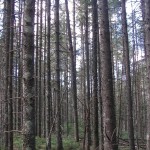
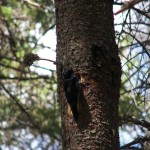
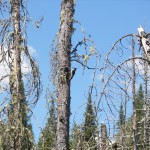
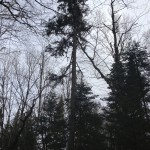
Staying one more day in Lake Placid. Would love to see a Black-backed Woodpecker. Looking for recommendations on where to go. Thanks.